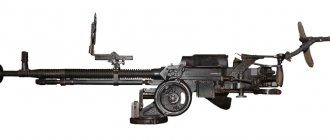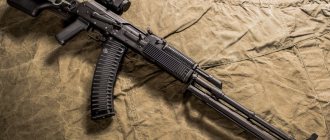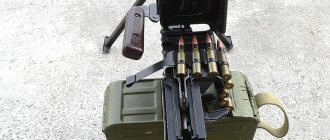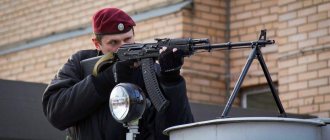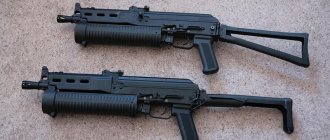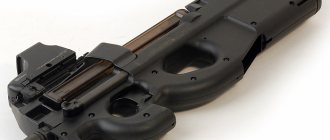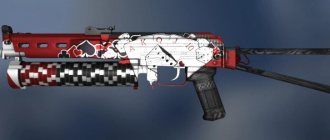The 7.62-mm Goryunov machine gun (SG-43, GAU Index - 56-P-428) is a Soviet heavy machine gun.
Story
After the defeat of the Nazis near Moscow, the question of a lightweight machine gun arose with new urgency. Maxim's machine gun continued to reliably serve our army thanks to the power and accuracy of its fire. However, although indispensable in defensive battles, the heavy weight of the machine gun had a negative effect on the offensive. Another factor was that the water needed to cool the barrel was not always available. One of the reviews from the front stated: “In terms of its weight (70 kg), the Maxim machine gun is an unsatisfactory design that reduces the maneuverability of units... The experience of military units in the use of heavy machine guns in the Patriotic War showed that heavy machine guns weighing over 40 kilograms in offensive operations are heavy and do not meet the conditions of maneuver warfare...”
In May 1942, in accordance with the order of the People's Commissar of Armaments of the USSR D.F. Ustinov, a competition was announced for the development of a new design of an easel machine gun for the Red Army (to replace the Maxim machine gun model 1910/30)
After the war, V. A. Degtyarev recalled: Another designer, hitherto unknown, announced himself. He was Pyotr Maksimovich Goryunov, who worked at the Kovrov plant. He was not young, he worked with us for fifteen years, he was known as an amazing craftsman, but he never showed himself either as an inventor or as a designer. And suddenly one day, just before dawn, Goryunov comes to me with a large package. This was the summer of 1942. — Vasily Alekseevich, look at the model of my machine gun. I’ve been going to see you many times, but I’ve always felt ashamed. I examined Goryunov’s model and, I admit, I couldn’t believe my eyes. The model was conceived taking into account the latest achievements in weapon automation. - When did you do this, Maksimych? - I asked. “I’ve been thinking about it for a long time, but I assembled the model recently, when I heard that we were given the task of creating a new heavy machine gun.
Goryunov SG-43 heavy machine gun
An experimental machine gun proposed for the competition, developed at the Kovrov Mechanical Plant by gunsmith P. M. Goryunov with the participation of M. M. Goryunov and V. E. Voronkov, was transferred for testing at the end of 1942. In May 1943, the results of field tests were summed up, according to the results of which the Goryunov machine gun won the competition for heavy machine guns.
On May 15, 1943, under the name SG-43, the heavy machine gun was adopted by the Red Army. The SG-43 began to enter service with the troops in June 1943. In 1944, designers G. Garanin and V. Seleznev developed a simplified wheeled machine for the SG-43, which was characterized by much higher performance when operating in difficult conditions.
In 1945, the machine gun itself was improved. To improve heat transfer, the barrel received transverse ribs instead of a smooth outer surface, the reloading handle, for ease of shooting from a prone and sitting position, was moved from under the fire control handles to the right side of the receiver, and an adjustable barrel lock was introduced, which made it possible to replace the heated barrel almost seamlessly.
Goryunov SGM heavy machine gun (on a wheeled machine, with a shield)
In general, before the end of the Great Patriotic War, over 80 thousand SG-43s were manufactured and transferred to the active army. Soon after the end of the Great Patriotic War, the machine gun was once again modernized. The rearmament of Soviet Army units with Goryunov machine guns was completed in the late 1940s and early 1950s.
Automation or parts of the SG-43 device were subsequently used to create single machine guns Type 67, KGK and SS-77. A single machine gun designed by Silin and Pererushev based on the SGM participated in the 1956 competition for a single machine gun, in which the Kalashnikov machine gun won.
For the creation of an easel machine gun, which was widely used at the front, Pyotr Maksimovich Goryunov (posthumously), Vasily Efimovich Voronkov, Mikhail Mikhailovich Goryunov and Vasily Alekseevich Degtyarev were awarded the Stalin Prize of the first degree.
Goryunov P.M. died on December 23, 1943, returning from Moscow, where he was debugging his machine guns before being sent to the front.
Top view of the SGM receiver, the lid is open; the gripper that removes the cartridges from the belt and the charging handle are visible.
Direct shot range:
– according to the chest figure – 420 m; – according to a running figure – 640 m.
The bullet retains its lethal effect throughout the entire flight range (up to 3800 m). The muzzle energy of a bullet with a steel core is 3511 J, the 1930 model bullet is 3776 J. The combat rate of fire is 250-300 rounds per minute. The barrel is cooled by air. Intensive burst fire is possible up to 500 rounds, after which it is necessary to replace or cool the barrel.
Requirements for normal single combat for the Goryunov machine gun:
– all four holes fit into a circle with a diameter of 15 cm; – the average point of impact deviates from the control point by no more than 5 cm in any direction.
Requirements for normal burst combat for the Goryunov machine gun:
– at least eight holes out of ten fit into a circle with a diameter of 20 cm; – the average point of impact deviates from the control point by no more than 5 cm in any direction.
The battle is checked by shooting at a test target (cut off along the fourth horizontal line) or a black rectangle 30 cm high and 20 cm wide, mounted on a white shield 1 m high and 1 m wide. Firing range - 100 m, cartridges - with an ordinary bullet (with steel core or lightweight model 1908), sight - 3 (on the “L” scale).
Weight
– 13.5 kg (machine gun body) – 36.9 kg (on a wheeled machine) – 27.7 kg (on a tripod machine) – 8.75 kg (a box with a loaded belt for 200 cartridges with bullets of the 1930 model) – 10 .25 kg (box with a loaded belt for 250 rounds of bullets of the 1930 model) – 8 kg (box with a loaded belt for 200 rounds of bullets with a steel core) – 9.5 kg (box with a loaded belt for 250 rounds of bullets with a steel core) steel core) – 8.25 kg (box with a loaded belt for 200 rounds with bullets of the 1908 model) – 9.75 kg (box with a loaded belt for 250 rounds with bullets of the 1908 model) – 0.6 kg (anti-aircraft foreshortening sight )
Options and upgrades
SG-43 - the first produced samples were installed on a Sokolov wheeled machine, but the serial SG-43s were installed on a wheeled machine designed by V. A. Degtyarev
SGM is a modernized machine tool, installed on a wheeled machine designed by V. A. Degtyarev or a tripod machine designed by Sidorenko-Malinovsky.
SGMB is an armored personnel carrier, mounted on the front, side or rear bracket of an armored personnel carrier.
SGMT is a tank type, installed inside the tank turret on the gun cradle bracket, and has an electric trigger.
Device
The body of the Goryunov machine gun consists of the following main elements:
– barrel, – receiver with sight, – barrel lock, – receiver, – bolt carrier with piston, – bolt, – reloading handle, – trigger mechanism, – butt plate, – recoil spring.
The accessory of the Goryunov machine gun consists of: a cleaning rod, a combination wrench, an oiler, a drift, a extractor, an crank rod with a brush, a barrel locking key and a hammer.
The SGMT machine gun is equipped with an electric trigger in a special housing on the butt plate.
Sighting device
The sighting device of the Goryunov machine gun consists of a front sight and a sight, which in turn consists of a sight base, a sighting frame with a spring and a clamp with a rear sight. On the walls of the aiming frame there are divisions with numbers: for a light bullet of the 1908 model, a bullet with a steel core and special bullets - on the right side (the letter “L” and numbers from 0 to 20, indicating the range in hundreds of meters), for a heavy bullet of the model 1930 - on the left side (letter “T” and numbers from 0 to 23). There is a mark on the rear sight, and on the back side of the clamp there are marks for lateral corrections (five marks to the left and right of the main mark) for installing the rear sight. Each division of the rear sight is equal to one thousandth of the range.
To fire at air targets, an anti-aircraft sight is installed on the machine gun, designed to fire at air targets moving at a speed of no more than 600 km/h at ranges up to 1000 m. This sight consists of a sight base, front and rear visors. The front visor consists of concentric rings (with radii of 20, 40, 60 and 80 mm) for selecting lead, a central ring for sight alignment and a front visor stand. The rear sight consists of a ball, a locking screw (for sight alignment) and a rear sight stand.
Automation operating principle
The operation of the SG-43 automation is based on the use of the energy of powder gases removed from the barrel bore. The barrel bore is locked by tilting the bolt to the right. When fired, part of the powder gases that push the bullet out is directed through a hole in the barrel wall into the gas chamber and presses on the piston, causing the bolt frame to move back. The bolt remains in place until the bullet leaves the barrel, closing it and preventing gases from escaping into the receiver.
After the bullet leaves, the moving parts continue to move back, thereby compressing the recoil spring. The bolt opens the bore and removes the cartridge case from the chamber. The engine removes the next cartridge from the belt and feeds it into the longitudinal window of the receiver. The cartridge case is ejected from the receiver, the slide feeds the cartridge into the receiving window of the receiver.
If the trigger remains pressed, then the bolt frame with the bolt, under the influence of the return spring, rushes forward without stopping in the rear position. The bolt pushes the cartridge out of the longitudinal window of the receiver and sends it into the chamber. When the moving parts occupy the extreme position, the bolt closes the barrel bore. The firing pin breaks the cartridge's primer, a shot occurs, and the automatic operation repeats.
SG-43 (SGMB) on BRDM
Operating countries
– USSR – Poland: the first SG-43 machine guns were transferred to the 1st Army of the Polish Army during the Great Patriotic War, after the war the machine gun was adopted by the Polish Army under the name ckm SG-43 and was produced under license. – Hungary: produced under license. The modification had a pistol grip. – Vietnam – GDR – Egypt: produced under license. – Indonesia – China: produced under license. – Czechoslovakia: produced under license. – Belarus: removed from service in December 2005 and sent for disposal
SGM (SG-43) on a wheeled machine with an anti-aircraft foreshortening sight
Review of the Goryunov SG-43 heavy machine gun
Photo selection-1: “Goryunov machine gun on Degtyarev’s machine gun.” Photo selection-2: “Soldiers with a Goryunov machine gun.” Photo selection-3: “Detailed photos of the SG-43 and SGM machine guns”
The SG-43 machine gun or Goryunov heavy machine gun was supplied to the Soviet army under the designation GAU-56-P-42. The main designer of the machine gun is Pyotr Maksimovich Goryunov, who worked at the Kovrov arms factory. Assistance in the creation of the SG-43 machine gun was also provided by Vasily Efimovich Voronkov and Mikhail Mikhailovich Goryunov (nephew of P.M. Goryunov). So the first SG-43 machine gun could receive the abbreviation GVG (Goryunov-Voronkov-Goryunov). V. A. Prkofiev also provided assistance in the creation, who performed the technical calculations of the machine. According to some information, the GVG machine gun already existed in 1940, when it passed factory tests. The GVG machine gun was a manual one, not an easel one.
In May 1942, the People's Commissariat of Armaments of the USSR F. Ustinov ordered the development of a new heavy machine gun chambered for 7.62 mm, which should replace the Maxim heavy machine gun arr. 1910/30, which was bulky and had a very large mass of 65 kg in combat position versus 37 kg for the SG-43 . The Maxim machine gun was supposed to replace the Degtyarev DS-39 heavy machine gun, but combat experience during the “winter wars” with Finland showed its capriciousness with ammunition, as well as difficulty in production, and therefore it was discontinued a month before the start of the Second World War. In December 1942, 50 Goryunov heavy machine guns were manufactured, 45 of which were sent for military testing. The military gave a positive description of the machine gun, and also noted the disadvantages of the machine gun, after which the comments were eliminated. In May 1943, a competition was held to adopt a new heavy machine gun for the Soviet Army. The following machine guns took part in the competition: Goryunova, DS-43 (modernized DS-39), as well as the German MG-34. The military seriously considered converting the German MG-34 machine gun chambered for 7.62x54, but the design of the machine gun did not allow such a conversion, since the machine gun was designed to fire cartridges without a rim. During testing, the modernized Degtyarev machine gun turned out to be less advantageous due to complexity in production and reliability. Also, Goryunov’s machine gun turned out to be very reliable and had good accuracy.
The SG-43 machine gun is designed to fire at enemy personnel, enemy fire weapons with an effective distance of 600 meters, as well as shooting at air targets. It is worth noting that Stalin himself wanted to see a modernized DS-39 or a machine gun based on it as a new heavy machine gun. After the tests, Stalin asked Degtyarev what kind of machine gun the army needed, to which Degtyarev said: “If we proceed from the interests of the army’s combat capability, then the heavy machine gun of the Goryunov system should be adopted.” The problem with Goryunov’s machine gun was that he was previously a little-known gunsmith. On May 14, 1943, the SG-43 was adopted by the Soviet army. The first machine guns in the fall of 1943 began to arrive at the front from the Kovrov Arms Plant, where Corps “I” (later called “Komsomolsky”) was built for their production in 2.5 months. Since 1944, the production of machine guns was additionally established in Zlatoust. On December 23, 1943, Pyotr Maksimovich Goryunov died - this is the birth of the machine gun and the death of its creator.
Aim
The Goryunov Sg-43 machine gun has a stationary frame sight for firing light bullets of the 1905 model and heavy bullets of the 1930 model. The sighting frame had divisions with an aiming range of up to 2000 (light bullet) and 2300 heavy bullet. Also, for shooting at aircraft, it was possible to use a removable angle (anti-aircraft sight), which made it possible to conduct pre-emptive fire at aircraft flying at speeds of up to 600 km/h.
Automation.
The automation of the SG-43 is based on the energy of part of the powder gases, which push the piston with the bolt to repeat the cycle. Metal or rag belts are used to power the store. Feeding the cartridge occurs in two stages: capturing the cartridge from the tape and feeding it into the barrel, followed by pinching the primer. Locking the cartridge into yours is done by skewing the barrel. During the shot, the mainspring was compressed, which ensured that the cartridge was driven into the chamber and the primer was pinched.
A feature of the SG-43 from its brother, the Maxim machine gun, was air cooling with the ability to fire continuously up to 500 rounds, as well as lower weight, since there was no longer a need for water cooling. Water cooling significantly increases the weight of the machine gun, plus it complicates the search for water for cooling, and the cooling casing is significantly susceptible to damage from cleats. The SG-43 had the ability to quickly change the barrel during intense combat. An important advantage of the SG-43 was the quick ability to use the machine gun as an anti-aircraft machine gun with the help of an anti-aircraft machine gun and a machine gun, which can be used from a prone or standing position. During the war, about 80,000 SG-43 . In 1945, the machine gun underwent modernization. The reloading handle was moved from underneath to the right, plus it became more massive and more convenient. The barrel received ribs and valleys to improve cooling, which had a positive effect on the accuracy and life of the barrel. The tape drive mechanism received covers to protect the mechanism from dirt and precipitation. The new machine gun received the abbreviation SGM . Replaceable barrels of the SG-43 and SGM machine guns are interchangeable.
SGM also entered service with armored forces. So for there was a model SGMB-easel Goryunov, a modernized armored personnel carrier and SGMT-easel Goryunov, a modernized tank. The tank SGM was installed as a coaxial machine gun for the cannon and had an electric release of fire. After 1949, the barrels of the SG-43 became transverse radiator fins. You can blame the SG-43 for its weight of 36 kg and a bulky machine with an anti-fragmentation shield, but thanks to its mass, recoil was reduced and the accuracy of fire over long distances was significantly increased. And the shield provided protection from shrapnel and expiring bullets, and also morally increased the spirit of the fighter who had the protection. The advantage was the transformation of the machine into an anti-aircraft machine gun, which provided shooting at low-flying targets and the ability to install a machine gun inside buildings.
Results
The Goryunov SG-43 appeared and turned out to be a reliable machine gun, which replaced the Maxim machine gun. It became the main machine gun for several decades for armored forces and infantry. On the basis of the SG-43, licensed copies of machine guns were created in different countries of the world.
The rearmament of the Soviet army with machine guns ended in the early 1950s. In 1956, Goryunov was replaced by machine guns of the Kalashnikov family. Arms factories were able to supply the army with over 80,000 SG-43 and SGM machine guns. Technical characteristics of the Goryunov SG-43 / SGM machine gun
| Number of shots | 200/250 in tape |
| Barrel diameter | 7.62x54mm, 4 grooves |
| Combat rate of fire | 250-300 rounds per minute |
| Maximum rate of fire | 600-700 rounds per minute |
| Sighting range | 2300 meters |
| Effective sighting range | 600 meters |
| Maximum firing range | 3800 meters |
| Initial departure speed | 855 m/s |
| Automation | gas outlet, two cycles |
| Weight | 13.5 kg empty, 36.9 kg on a wheeled machine, 27.7 kg on a tripod, boxes with tape for 200/250 cartridges 8/9.4 kg |
| Dimensions | 1140 |
How to replace "Maxim"?
By the beginning of World War II, the problem of creating an infantry support weapon at the battalion level—a heavy machine gun—could not be solved. The Maxim, which was in service with the Red Army, had a number of significant shortcomings that could not be overcome. The main one was the impressive weight of the heavy machine gun - when equipped, that is, filled with water and loaded, its mass was 63 kg. The water cooling of the Maxim also did not add convenience, since finding water in combat conditions is often difficult, if not impossible. In addition, shrapnel and bullets easily damaged the casing, rendering it unusable.
Initial plans to replace the Maxim machine gun with the DS-39 model were not implemented, since the weapon turned out to be difficult to manufacture and operate, and unreliable at low temperatures and dust. As a result, the DS-39 was discontinued.
Start of production
On May 14, 1943, the State Defense Committee decided to adopt the Goryunov machine gun (photo given in the article) with a wheeled machine gun. For its production, a separate workshop was built at the Kovrov Mechanical Plant in two and a half months. In the fall of 1943, the first batch of weapons was produced, and the following year production was expanded by the capacity of the Zlatoust plant No. 54.
At the same time, developers Seleznev and Garanin designed a simpler wheeled machine that had better performance characteristics when working in difficult conditions.
In total, before the end of the war, more than 80 thousand Goryunov machine guns were produced and transferred to the Red Army.
Guidance system
Sights on the SG-43 include a pin front sight and a folding sight. The latter includes a base, a clamp with a whole and a frame with a spring. There are two scales on the frame. The left one is intended for cartridges with 1908 bullets and allows you to set a distance of up to 2 thousand m. It is designated by the letter “L” and the numbers 0–20. The right scale is intended for a cartridge with a 1930 bullet and allows you to set a distance of up to 2.3 thousand m. It is marked with the letter “T” and the numbers 0–23. There is a risk on the rear sight. To install it, the rear part of the clamp on both sides of the main mark is marked with five divisions of lateral corrections. One mark corresponds to a thousandth range.
The Goryunov system machine gun is verified by firing at a verification target cut along the 4th horizontal line, as well as at a black rectangle measuring 20x30 cm on a 1x1 m white shield. The range is set to 100 m, the sight is set to 3 on the left scale and cartridges with a light bullet are used.
Use in combat
The Goryunov machine gun entered service in the spring of 1943. The weapon reached rifle battalions in the early summer of that year. It was used to destroy open groups of enemy personnel and fire weapons at distances of up to 1 km.
The success of the Goryunov in the battles of the final period of the war was due to its light weight: it was 6.5 kg lighter than the Maxim, and with a wheeled machine - 25 kg.
After World War II, the machine gun was modernized and renamed SGM (“M” - modernized). The dust protection and barrel cooling system was improved, and a new bolt was installed. A tank version of the SGMT appeared.
Modification of SHG
In May 1942, development began on a new machine gun design chambered for a 7.62 mm cartridge. This is where the GVG came in handy, which was successfully tested at the manufacturing plant in 1940.
The Goryunov light machine gun was developed at the Kovrov Mechanical Plant by Pyotr Maksimovich Goryunov, his nephew Mikhail, as well as the plant foreman Vasily Voronkov. The weapon was named after the first letters of these surnames - GVG.
But the Red Army required an easel version, and Goryunov adapted the machine gun to perform new tasks.
Anti-aircraft sight
Targets in the air are tracked using an additionally installed anti-aircraft sight on the Goryunov, designed for airborne objects at a distance of no more than 1 kilometer, which move at a speed not exceeding 600 km/h. The scope has front and rear sights and a base. The front one is composed of four concentric rings with a radius of 20–80 mm with a pitch of 20 mm, the purpose of which is to select the lead. In addition, the sight in the center has a ring that serves for adjustment, as well as a stand. The rear one is made up of a ball, a locking calibration screw and a stand. A distinctive quality of the sight is the installation of both sights on a frame that connects them into a single structure, which ensures the consistency of its settings: it can be repeatedly removed, folded and installed in place without disturbing the settings.
Main characteristics
The main parameters of the machine gun are:
- Weight: 13.5 kg.
- Machine weight: 23.4 kg.
- Length: 1140 mm.
- Barrel length: 720 mm.
- Firing range (L/T): 2000/2300 m.
- Bullet speed (L/T) F 865/800 m/s.
- Rate of fire: 700 rounds/min
- Rate of fire: max. 350 rounds/min.
The SG-43 was widely exported, and licenses for its production were issued in several countries. In China, the Goryunov was produced under the name Type 53, in Czechoslovakia as the Vz 43, in Poland (Wz 43) and in South Africa (SS-77).
